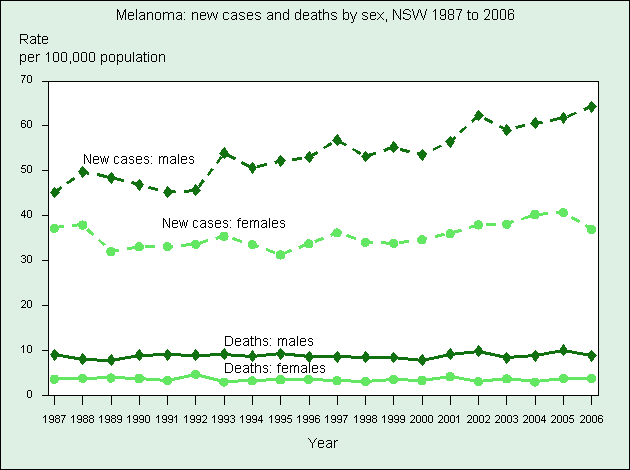In relation to the epidemiology of melanoma, we can undoubtedly state that the incidence is constantly increasing and higher than any other form of cancer; in Italy in the early 90s the annual incidence was about 4 new cases per 100,000 inhabitants, currently the estimate is that there are 10 new cases per 100,000 inhabitants.

In the United States in the 1930s the risk of developing melanoma was 1 in 1,500 people, now it is 1 in 75 people. In the European Union the incidence is around 9 cases per 100,000 inhabitants per year and in Italy it represents around 1.5% of cancers diagnosed in men and 2.1% in women and furthermore in Italy the incidence is higher in the north than in the south. In any case, these data appear to be underestimated, given that many melanomas are removed in non-hospital facilities and therefore not recorded.
The reasons are not entirely clear, but lifestyle changes with intense (often due to the obsession with the perfect tan), intermittent sun exposures, the use of UV lamps, holidays in warm places during the winter have favored the increase of sunburns and therefore of the risk of developing a melanoma.
In my daily practice I have met patients with melanoma who spent the whole summer going to the beach from 12 to 15, who went on beach holidays in winter and who, in order not to lose their tan, exposed themselves weekly to artificial lamps for the whole year.
Even children are not spared from the change of habits, I remember that in the seventies mothers took us to the beach early in the morning and late in the evening, nowadays it is difficult to see a child at the beach at 9, they are often taken to the beach at 11, protective cream is applied to him and then after 10 minutes the child is sent to take a bath, in such a way that the protection disappears and the child is dangerously exposed to solar radiation.
In recent years the mortality rate for melanoma has begun to decrease, this is due more than to an effective therapy to an early diagnosis by the dermatologist following the use of suitable instruments such as the dermatoscope.
The 5-year survival rate in the United States went from 67% in 1975 to 82% in 1994 and the mortality rate is higher in men and the elderly. It predominantly affects adults (the average is around 50 years of age) even if the melanomas arising on congenital melanocytic nevi are more frequent in children and instead the lentigo maligna melanoma affects the elderly.
As far as the epidemiology of melanoma is concerned, females (about 55% of cases) are more interested than males, in women the face and legs are mainly involved, in men the trunk.
The incidence of melanoma varies geographically, populations of Anglo-Saxon origin who migrated to warmer places have a high incidence of melanoma (in Australia the incidence among whites is 35 cases per 100,000 inhabitants per year). In Australia, however, the effectiveness of prevention campaigns have led to an increase in the removal of in situ or subtle melanoma.
Melanoma epidemiology: melanoma in the black race
Melanoma in dark race populations has a much lower incidence than in the Caucasian race (about 16 times higher). Studies have found a greater incidence in Asian populations than in Africans and among Africans there is a greater frequency in the plantar regions: initially this figure was considered linked to the traumatism derived from the fact that many African tribes do not wear shoes, in reality a very similar incidence was also demonstrated in black Americans.
In black African populations there is also a low frequency of melanomas on the legs, confirming the protective role of skin pigmentation.
However, the oncogenesis of melanoma in African-American populations remains undefined and sun exposure also seems less critical in these populations, leading us to believe that melanoma is a genetically heterogeneous disease with diverse etiologies.
Epidemiology of melanoma: incidence of melanoma in various ethnic groups from 2001 to 2005
| Race | Male (every 100,000) |
Female (every 100,000) |
| All breeds | 24.6 | 15.6 |
| Caucasians | 28.5 | 18.5 |
| Blacks | 1.1 | 0.9 |
| Asian and Pacific Islands | 1.6 | 1.3 |
| Alaskan Indian and Native Americans | 3.9 | 2.6 |
| Hispanics | 4.8 | 4.9 |
As we can see from the table, the epidemiology of melanoma shows a significant difference in incidence to the detriment of Caucasian ethnic groups.